I tried all the popular productivity systems. This is what finally stuck.
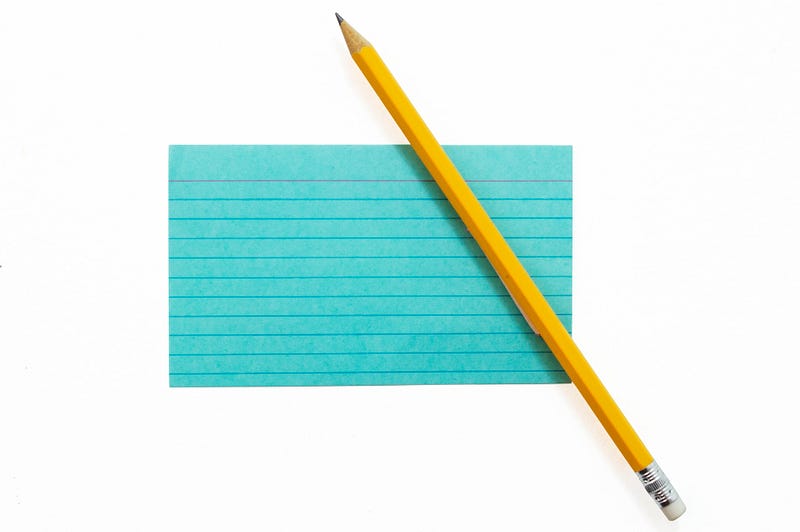
Photo: Netalieh/Getty Images
For the better part of a decade, I’d get frustrated at myself for not
being able to make popular productivity systems to work for me.
GTD, the Bullet Journal Method, Day Designer, The Franklin Covey
planner, the Ivy Lee Method, time-blocking — I tried them all. Even
if I kept up with a system for a couple months or so, I would
inevitably lose motivation.
Then one day in November 2020, neck-deep in pandemic-induced
frustration, I took out a 3×5 card and wrote down the most important
things I needed to get done that day. Next to each task, I put a point value. At the end of the day, I tallied my score. I vowed to get the same score or
better the next day.
Nearly a year later, I still fill out an index card every day—and I’ve become more productive, focused, and motivated because of it. I call the simple practice The Today System.
How it works
- Grab a 3x 5 lined index card and something to write with.
- Flip the card to the unlined back, and position it vertically. Set a timer for three minutes, and write down every task you think you should try to get done today.
- Flip the card over to the lined side. Put today’s day and date at the top, and make it look like the picture below.
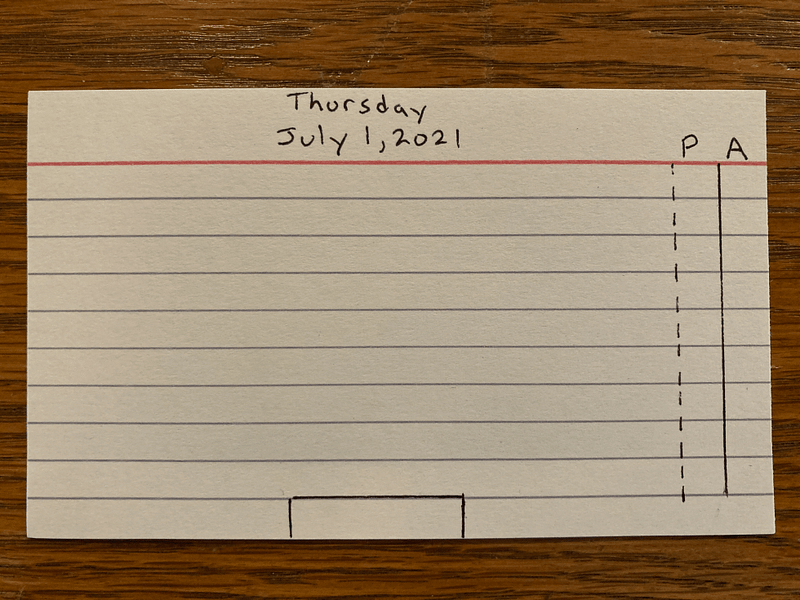
- Using your task list from the back, begin listing the most important tasks you have time to do today¹, in order of importance.² Pick no more than 9 tasks (one for each line). The first item is #1, the second is #2, and so on. Your card should look like this:
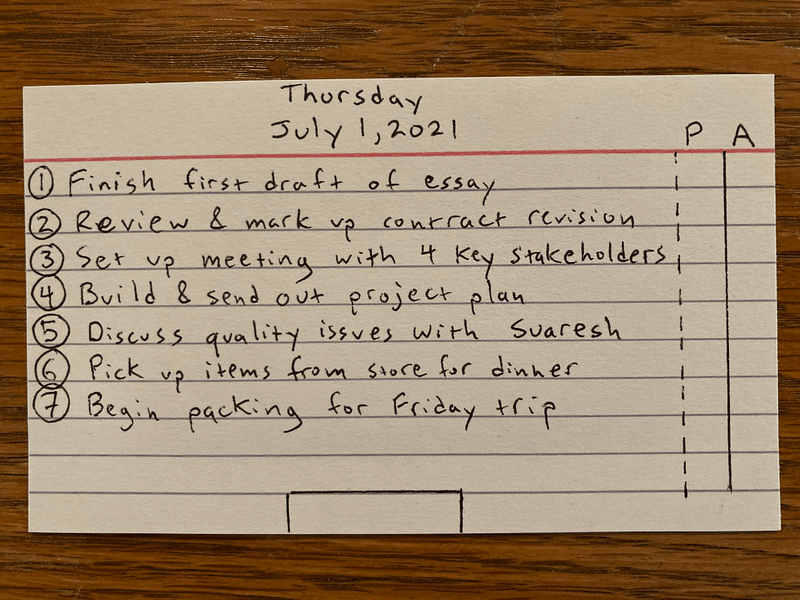
- In the “P” column, place the point value for each item using the following scheme:
– Item #1 gets a point value equal to the total number of tasks.
– Item #2 gets a point value equal to 1 less than the item above it.
– Repeat until you get to the final item on your list, which is worth 1 point.
Your card should look something like the picture below:
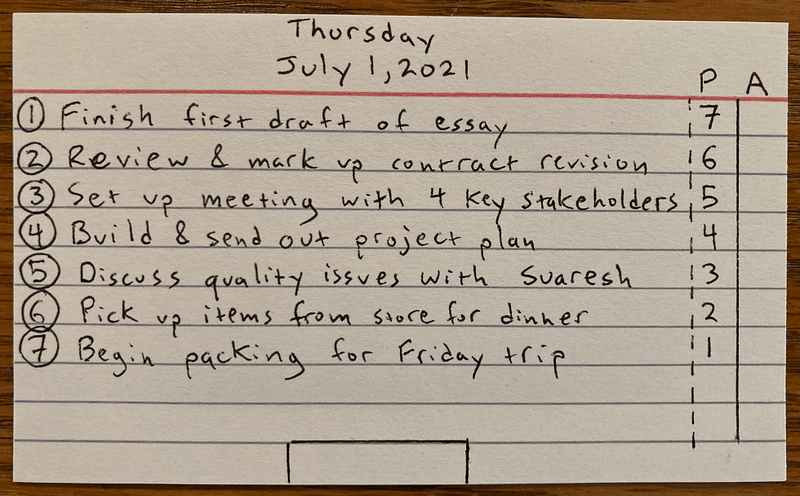
- Add up all the possible points in the “P” column. That’s your possible points value for the day.³
- As you complete items, cross them off the list, and award yourself the point value for each in the “A” column.⁴
- At the end of the day, add up the total points you’ve earned, and place that at the bottom of the “A” column. Take that amount, divided by your total points possible, and put that in the box at the bottom of your card.
Below is an example of a card with a full score at the day’s end.
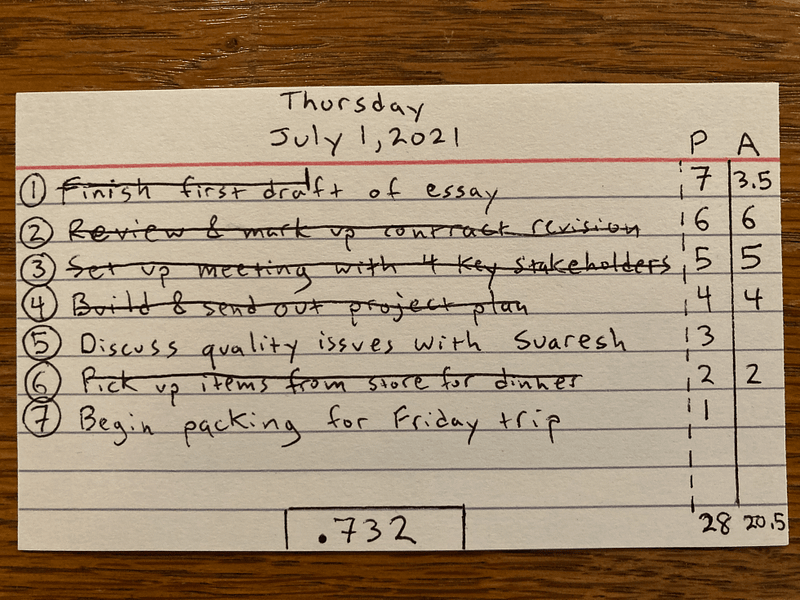
Aim for a score of .750 or greater. If you achieve that, keep it up! If you score lower, think about fewer items per free hour tomorrow. Repeat each day.
Why it works
This is the one system that I haven’t become overwhelmed or repulsed by. I’m sure the fact that I came up with it for myself is a part of that. But I’ve built systems for myself before, none of which stuck.
I think there are three key features of the system that have allowed it to work so well for me. And they’re features that others who’ve given me feedback have also identified.
Visual separation
I’ve used countless apps, notebooks, and planners over the years in an effort to make my days more productive. In the best of times, they’d help for a few days here and there. But more often than not, they’d be another source of distraction. Any time I looked at one of them to see what I needed to focus on for the day, there was always the risk of getting lost in the noise of everything else I kept there.
The great thing about deciding on tasks and putting them on a separate card is that there’s no inherent noise. There is only one place I have to look to remind myself what’s important today. And it’s very easy to see which things are more important than others.
Gamification
This system continues to work for me because it harnesses the power of making productivity each day into a game. It makes prioritization into a game. I can see how well I’m doing with a simple number. And when the day is coming to a close, and my score is not what it should be, I get motivated to get those things done I told myself I would.
Metrics and feedback
When it comes to productivity, it should be clear that the quantity of tasks you get done matters little compared to the importance of the tasks you get done. But a traditional to-do list uses only the quantity of tasks as a numerical metric, and so provides little in the way of useful feedback.
The scoring system on the card helps to show you not how many things you got done, but how important the things you got done were. And you’re the one who assigns a point value to each score, so you’re getting direct and quick feedback on how well you’re doing being intentional and following your own sense of importance.
Taking the system further
Filling out the card each day and using the scoring system is just the first of four levels I’ve built into the system. The next three levels are optional, but strongly encouraged. They’ve helped me continue to be not only productive each day, but also to reflect, plan ahead, and use my scoring system to continuously improve.
Level 2 is the inclusion of a simplified scheduling system to better prepare for listing tasks on the card every day. It’s basically a running task list, separated into suggested timeframes: today/tomorrow, the next few days, this week, and next week & after.
Level 3 is the use of a spreadsheet I created in order to track your score each day, and enter notes to reflect on how the day went, and how I can improve tomorrow. There’s also space to conduct a three-part weekly reflection — using my compiled score for the week, and using that to see what I can do to improve in the coming week.
Level 4 involves building and streamlining a list of bigger projects above the running task list — and then ensuring that they fit into a higher-level short list of goals. Those goals then become the barometer for which tasks should be the highest point-value ones the cards each day.
If you’re interested in learning more, head over to the website. You can read the in-depth guide on all 4 levels, as well as sign up for a one-week crash-course that consists of an e-mail a day.
Footnotes
- Don’t overload yourself with tasks to do, especially if you already have things you’re committed to doing/attending today. A good rule of thumb is this: count only the amount of hours you have free to do tasks today (i.e., not time in meetings, running errands, cooking dinner, self-care, or other pre-existing commitments). Take that quantity of hours and multiply it by 1.25. That’s roughly the amount of tasks that should go on the front of your card.
- I take the word “important” to mean a task that contributes to meaningful life goals of yours — things that you consider worth doing in order to make your life better. While others’ goals for you may seem pressing (like getting your boss some document she requested), don’t assume that automatically makes them important.
- A quick way to add up your possible points is to use a fun mathematical concept called the termial. Simply take the count of the items on your list (in our example, it’s 7). Multiply that by the count of items plus 1 (in our example, that would be 8). Then divide that by 2, and that is the total possible points.
- Half points are possible for items that you put forth a respectable amount of effort toward, but didn’t complete. For example, if you had 9 items on your card, and you made progress on item 1, but didn’t finish it, award yourself 4.5 points.